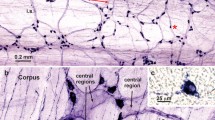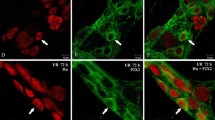Abstract
Abstract Nitric oxide (NO) synthase activity in rat isolated longitudinal muscle myenteric plexus preparations of the small intestine was determined by measuring the accumulation of 3H-L-citrulline during 30 min incubation with 3H-L-arginine.
In untreated preparations a significant amount of 3H-L-citrulline accumulated in the tissue, about 2000 dpm/30 mg per 30 min, accounting for about 1.7% of the tissue radioactivity. Intermittent electrical field stimulation (15 Hz, 10 s trains with 10 s intervals for total of 20 min) caused a threefold increase in 3H-L-citrulline accumulation. The NO synthase inhibitor Nω-nitro-L-arginine methyl ester (L-NAME) reduced the spontaneous accumulation of 3H-L-citrulline by 65% and prevented the electrically evoked increase. Removal of extracellular calcium or addition of tetrodotoxin blocked the electrically evoked increase in 3H-L-citrulline accumulation without affecting spontaneous accumulation. Application of the calcium ionophore A 23187 (10 μmol/1) or 45 mmol/1 potassium caused a twofold increase in the accumulation of 3H-L-citrulline. The muscarine receptor agonist oxotremorine (1 μmol/l) had no effect on spontaneous accumulation of 3H-L-citrulline, but inhibited the electrically evoked increase by about 50%, and this effect was blocked by scopolamine. A substantial amount of 3H-L-citrulline (15 000 dpm) accumulated also in the incubation media, and this was increased 1.7-fold by the presence of A 23187 and 2.7-fold by electrical stimulation. However, electrically evoked increase in 3H-L-citrulline was not prevented by tetrodotoxin, in contrast to observation on tissue levels.
In conclusion, during incubation with 3H-L-arginine tissue levels of 3H-L-citrulline in rat isolated longitudinal muscle myenteric plexus preparations, but not accumulation in incubation media may be used as a biochemical marker of the activity of nitrergic intestinal neurons which appear to be inhibited via muscarine receptors.
Similar content being viewed by others
References
Aimi Y, Kimura H, Kinoshita T, Minami Y, Fujimura M, Vincent SR (1993) Histochemical localization of nitric oxide synthase in rat enteric nervous system. Neuroscience 53:553–560
Berrino L, Hey C, Rossi F, Racke K (1994) Characterization of nitrergic transmission in rat myenteric plexus by monitoring formation of 3H-citrulline from 3H-arginine. Naunyn-Schmiedeberg's Arch Pharmacol 349 [suppl]:R22
Bredt DS, Snyder SH (1989) Nitric oxide mediates glutamate-linked enhancement of cGMP levels in the cerebellum. Proc Natl Acad Sci USA 86:9030–9033
Bredt DS, Hwang PM, Snyder SH (1990) Localization of nitric oxide synthase indicating a neural role of nitric oxide. Nature 347:768–770
Catterall WA (1980) Neurotoxins that act on voltage sensitive sodium channels in excitable membranes. Annu Rev Pharmacol Toxicol 20:15–43
Förstermann U, Gorsky LD, Pollock JS, Ishii K, Schmidt HHHW, Heller M, Murad F (1990) Hormone-induced biosynthesis of endothelium-derived relaxing factor/nitric oxide-like material in NIE-115 neuroblastoma cells requires calcium and calmodulin. Mol Pharmacol 38:7–13
Förstermann U, Pollock JS, Schmidt HHHW, Heller M, Murad F (1991) Calmodulin-dependent endothelium-derived relaxing factor/nitric oxide synthase activitiy is present in the particulate and cytosolic fractions of bovine aortic endothelial cells. Proc Natl Acad Sci USA 88:1788–1792
Förstermann U, Closs EL Pollock JS, Nakane M, Schwarz P, Gath I, Kleinert H (1994) Nitric oxide synthase isozymes. Characterization, purification, molecular cloning, and functions. Hypertension 23:1121–1131
Fuder H, Muscholl E (1995) Heteroreceptor-mediated modulation of noradrenaline and acetylcholine release from peripheral nerves. Rev Physiol Biochem Pharmacol 126:265–412
Furchgott RF, Zawadzki JV (1980) The obligatory role of endothelial cells in the relaxation of arterial smooth muscle by acetylcholine. Nature 288:373–376
Grozdanovic Z, Baumgarten HG, Bruning G (1992) Histochemistry of NADPH-diaphorase, a marker for neuronal nitric oxide synthase, in the peripheral autonomic nervous system of the mouse. Neuroscience 48:225–235
Hey C, Wessler I, Racké K (1995) Nitric oxide synthase activity is inducible in rat, but not rabbit alveolar macrophages, with a concomitant reduction in arginase activity. Naunyn-Schmiedeberg's Arch Pharmacol, 351:651–659
Kilbinger H (1988) The autonomic cholinergic effector junction. In: Whittaker VP (ed) The cholinergic synapse (Handbook of experimental pharmacology, vol 86). Springer, Berlin Heidelberg New York, pp. 581–595
Knowles RG, Palacios M, Palmer RMJ, Moncada S (1989) Formation of nitric oxide from l-arginine in the central nervous system: a transduction mechanism for stimulation of soluble guanylate cyclase. Proc Natl Acad Sci USA 86:5159–5162
McConalogue K, Furness JB (1993) Projections of nitric oxide synthesizing neurons in the guinea-pig colon. Cell Tissue Res 271:545–553
Moncada S, Palmer RMJ, Higgs EA (1991) Nitric oxide: physiology, pathophysiology and pharmacology. Pharmacol Rev 43:109–134
Palmer RMJ, Moncada S (1989) A novel citrulline-forming enzyme implicated in the formation of nitric oxide by vascular endothelial cells. Biochem Biophys Res Commun 158:348–352
Palmer RMJ, Ferrige AG, Moncada S (1987) Nitric oxide release accounts for the biological activity of endothelium-derived relaxing factor. Nature 327:524–526.
Starke K, Göthert M, Kilbinger H (1989) Modulation of neurotransmitter release by presynaptic autoreceptors. Physiol Rev 69:864–989
Wiklund NP, Leone AM, Gustafsson LE, Moncada S (1993a) Release of nitric oxide evoked by nerve stimulation in guinea-pig intestine. Neuroscience 53:607–611
Wiklund CU, Wiklund NP, Gustafsson LE (1993b) Modulation of neuroeffector transmission by endogenous nitric oxide: a role for acetylcholine receptor-activated nitric oxide formation, as indicated by measurements of nitric oxide/nitrite release. Eur J Pharmacol 240:235–242
Author information
Authors and Affiliations
Rights and permissions
About this article
Cite this article
Berrino, L., Hey, C., Rossi, F. et al. Stimulation-induced 3H-l-citrulline accumulation in isolated longitudinal muscle myenteric plexus preparations of rat small intestine: a measure to characterize nitrergic neurons. Naunyn-Schmiedeberg's Arch Pharmacol 352, 506–511 (1995). https://doi.org/10.1007/BF00169384
Received:
Accepted:
Issue Date:
DOI: https://doi.org/10.1007/BF00169384




